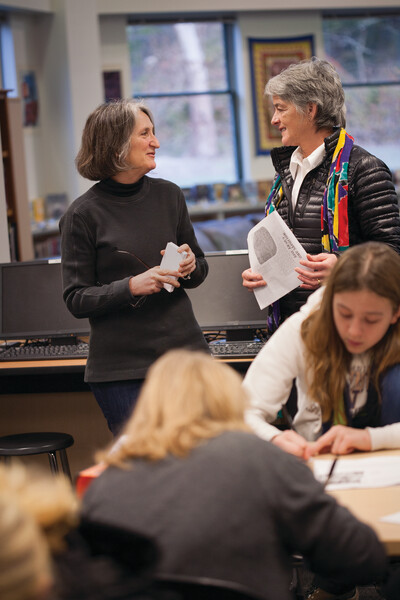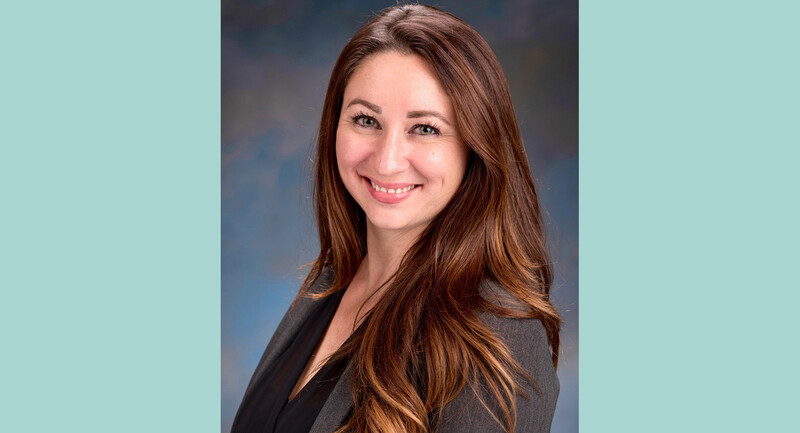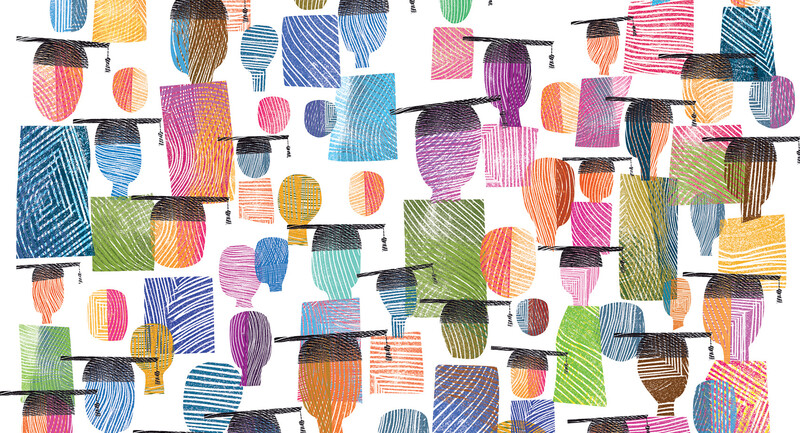My first job as a special education teacher was in a public middle school in the 1970s. My students were the ones who were disruptive to the ordinary workings of the school community. My classroom was in the basement, at the end of a long hall, next to the janitor's office; my students were as far away from the other students as they could possibly be without being considered an "outside placement."
I soon realized that my sole job was to keep my students from disturbing others. When I asked the principal whether my students could organize a schoolwide contest to guess the number of marbles in a fish tank, all he said was, "No. That's probably not a good idea." There were no expectations for me to develop partnerships with the rest of the staff.
I was an outsider too, younger and more idealistic than the veteran teachers. I made an effort to eat lunch with the other teachers every day, and they came to admire my perseverance, grudgingly giving me kudos for spending my days with "those students." At some point, perhaps in deference to my efforts, "those students" became "Benson's kids." My students were acceptable to the degree that I was acceptable.
There was one prominent, veteran teacher—let's call him Mr. X—who teased me, complained about my students, and patted me on the back in equal measure. One day at lunch, I walked into the staff room and heard Mr. X complaining about Joey, a boy who had alienated many staff members with his sour, noncompliant attitude. Joey had had a good couple of days in my room and for his efforts earned a pretzel rod, which he proceeded to brandish like a cigar, gaining him the attention he was seeking.
Mr. X said, "How do you like that? None of the other kids get rewarded for doing their work, but this one is walking around like he owns the place." Mr. X looked up and saw me. "Hey, Benson," he said, gesturing for me to sit at his table. "Come on over here. You've got a lot of explaining to do."
Later in the year, I convinced Mr. X to let Michael, my most academically competent student, into his class. Michael had a quick temper, often triggered by direct criticism of his behavior; he blamed others, raised his voice when asked to keep it lower, and then refused to work until he calmed down, which might take an hour. I learned how to approach Michael in ways that allowed him to hear feedback. I knew to leave him alone when talking to him would only have made his anger flare.
I provided Mr. X with an intervention plan because I knew Michael was going to have a bad day at some point. The plan was designed to get Michael out of the classroom before he had crossed any boundary that would make re-entry a scary proposition for him and everyone else. About a week into the placement, I was told that Michael was in the principal's office after he had exploded in Mr. X's room, and that he had had his last day in that class.
I found Mr. X in his room later that day. "Hey, Benson," he said. "I thought you had a plan in place so this wouldn't happen." There was a plan in place. But it required Mr. X to slow down his reaction when Michael's tone of voice was louder and less respectful than adults expect to encounter in a student.
"Oh no," I said, as I realized Mr. X hadn't understood his part. "This plan was in place for when Michael was having a bad day, so you could keep him from having a worse day."
"Well, that's not going to work," he said, underscoring what was by then all too obvious.
Challenges Today
That job, with all its growing pains, exemplifies how regular and special education teachers have historically struggled to find common language and common expectations. My work now brings me to many schools as a coach and consultant, helping special education and regular education staff work together. In many districts, I see and hear situations that are little different from my long-ago experiences. The structures and funding that I encountered 40 years ago are largely intact; we have not, as a nation, ever fully funded schools so that all students are able to maximize their gifts and master basic subjects. The recent pressure to mainstream students will save them from being warehoused in isolated rooms in the basement—and that's a good thing. But not establishing the infrastructure and support to connect regular and special education staff remains a problem in far too many schools.
Complicating the process of mainstreaming is the pressure on regular education teachers in particular to raise standardized test scores. The fear that the most competent students will have diminished test results as a result of mainstreaming is understandable. However, there is considerable evidence that most students are not hindered in their progress by the presence of students with special needs. Among many other studies, Waldron, Cole, and Majd (2001) found that nondisabled students made more measurable gains in math and reading in inclusive settings compared with students in classrooms that excluded students with disabilities. Unfortunately, in our testing culture, the other important goals of mainstreaming—teaching understanding, shared responsibilities, mutual support, diverse perspectives, and unique strengths—are neither measured nor widely celebrated as achievements.
Lessons from Successful Partnerships
The good news is that I have seen wonderful examples of teamwork between regular and special education teachers, often supported by leadership teams that go out of their way to make those crucial collaborations possible. In conversations between successful special education and regular education partners, I hear a shared appreciation of their perspectives. In those moments, the progress over the past several decades becomes clear. In particular, I'm impressed by how regular education teachers incorporate ideas from their partners, synthesizing into traditional classroom practice what we special education teachers have long wished everyone knew about our work. Keeping the following realities in mind helps this collaboration happen.
Children grow in unpredictable ways.
There is no magic. The skill set of the special educator does not include changing children into people they are not, as much as we all would like them to suddenly flourish. My student Michael walked into Mr. X's room as Michael.
Our work with students who do not learn in the same way or as fluidly as their peers leads us to hang in for the long run. We get used to looking beyond this year's standardized test scores (scores that may cause the regular education teacher significant stress). We work with the understanding that children don't change, but grow—sometimes slowly, rarely in leaps—in our supportive and appropriately challenging classrooms. Special educators subscribe to the idea beautifully articulated by John Hattie (2008):
Learning is spontaneous, individualistic, and often earned through effort. It is a timeworn, slow, gradual, fits-and-starts kind of process, which can have a flow of its own, but requires passion, patience, and attention to detail. (p. 2)
All teachers have the ability to set the classroom conditions for growth and learning, but we don't have the ability to change the student.
What successful partners do: They ask one another, "What skills can this student bring to the coming lesson? How many more repetitions might it take for this student to achieve mastery?" They catalog the student's strengths and abilities and reference those as they plan their next moves. Together the teachers identify the growing edge of each student and craft lesson plans to that edge.
Inclusion isn't a panacea.
My room by the janitor's office was far from ideal for the students and for me. The stigma of exclusion has always been a detrimental side effect for atypical children; I, too, fought that stigma to be accepted by the regular education staff. My isolated room denied my students access to competent peer role models.
On the other hand, for many of my students, my class was a safe haven, a place they knew was designed with their needs in mind. I greeted them warmly at the door each day, and my lessons did not assume they had mastered all the prerequisite skills. My early-career fumbling and improvisations to make my room a viable learning haven, even in its sad isolation, foreshadowed the understanding we have gained from the last 40 years of neuroscience: Our brains scan for and focus on threats in an environment before they can fully engage in learning. As Zaretta Hammond (2014) notes, "It is not enough to have a classroom free of psychological and social threats. The brain needs to be part of a caring social community to maximize its sense of well-being" (p. 47).
What successful partners do: They see the classroom as an inclusive community. They create rituals for greeting each student every day; they maintain consistent routines; they thoughtfully set up heterogeneous and homogeneous peer groups, depending on the day's lesson, creating both safety and challenge. Together they look at the classroom through the eyes of the struggling students and create a safe culture that leads all the students into the work.
It's better to create success than to fix failure.
Because of Michael's volatility, I knew that his placement in Mr. X's room was a risk. Other students would have behaved better, but would have been overwhelmed by the pace, prior knowledge, and skills required to keep up. I choose the competent student with a temper problem (and an intervention plan) over a calm student with deficits. In that era before e-mail, databases, and Google documents, I couldn't review and then scaffold Mr. X's lessons for one of Michael's calmer, but academically struggling peers. Looking back, putting Michael in that position seems naively optimistic, but putting a student who needed robust academic support into the mainstream was untenable.
That truth—the need for robust support—should be our touchstone all these years later. Too many students and teachers are in classrooms where plans to scaffold for deficits are in competition with many other responsibilities. That leaves the special education teacher to see the lesson for the first time with the students, and then to invent spontaneous accommodations. Under those conditions, the special educator often looks like a glorified teacher's aide, moving quickly around the room, trying to interpret and modify the lesson as it's unfolding in the moment. Those conditions lead to countless hours of students being confused, waiting for help, and needing a reteach. They reinforce feelings of incompetence—for both students and teachers.
What successful partners do: They work with administration to create schedules with common planning time. When that isn't possible, the lead teacher e-mails or posts the lesson plans so the special educator can study the lesson in advance. The special educator can then prepare the students for success prior to the lesson: previewing directions; introducing or reviewing specialized vocabulary; providing models of the task done well; and reformatting worksheets. Successful teaching partners prioritize the sharing of lesson plans to maximize success.
All teachers need to share ownership of all students.
A professional pitfall for the special education teacher is the feeling of being a knight in shining armor for the students with disabilities. I took a little too much pride in my students being labelled "Benson's kids." To the degree that I was seen as a good guy, that label had a positive spin and fed my ego for being noticed and appreciated.
The downside was that the rest of the staff felt less responsibility for the welfare of my students; those kids were mine to manage, or fail to manage, even though they had been referred from other teachers' classes. In his book Our Kids: The American Dream in Crisis (Simon & Schuster, 2015), Robert Putnam examines how schools and towns lose their collective ownership of all the children who will comprise the next generation by leaving the most vulnerable students on the margins of the community. I experienced that bifurcation in my first school. Mr. X expected that I would do all the work to ensure Michael's success, and I went along with that illusion.
Sometimes I still hear the students with IEPs referred to as "those kids" who belong primarily to the special educator, who shepherds them in and out of the mainstream. I used to think the "special" in special education was a compliment to the teacher—we were special! Now I realize it burdens all of us in schools; no one can be, or should be, expected to be so special. We are all judged by the successes and failures of all students, and their successes are maximized with shared ownership.
What successful partners do: The classroom is referred to by both teachers' names on the door, on the letters home, and on the report cards, if possible. Both teachers get students' attention to start the day or lesson, and both have the authority and expectation to speak to the class as a whole, to write on the board, to discipline, and to praise. When a group of students needs a reteach, just as often it is the lead teacher who works with that group while the special educator presents an extension lesson to the rest of the class. The special education teacher also leads the whole class in lessons that are in her skill set, allowing the lead teacher to focus on individual students.
Ultimately, special education teachers and regular education teachers have much in common. We all chose a career in schools. We share the same teachers' lounge, the same computer systems, and the same contracts, and we deal with the same school administration and community of parents. We also have much to appreciate in one another's unique efforts, as well as overlapping and distinct pressures. The history of special education is relatively short, and at times has imposed barriers between us all. Our future lies in building on the successful partnerships I see in many schools—partnerships that work for the teachers as much as they do for all our students.









